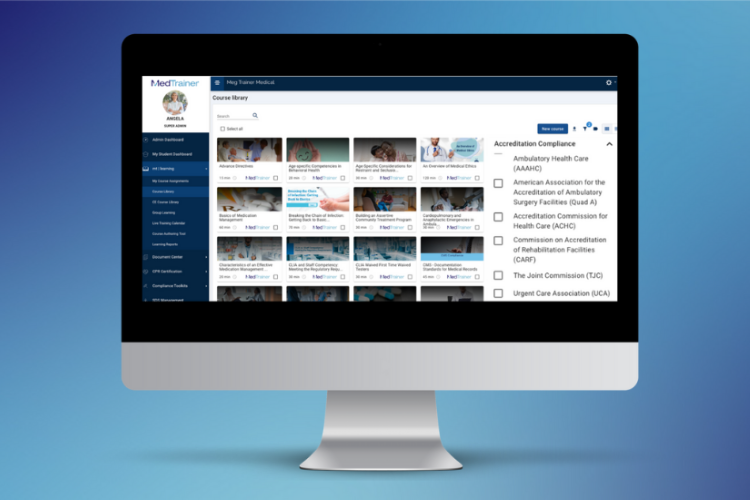Completing healthcare continuing education online offers many benefits, and saving time and money is one of the biggest for both professionals and their employers.
For most healthcare professionals, identifying resources that can meet continuing education requirements can be a complex and difficult to navigate task. This has become increasingly convoluted as state licensing boards introduce mechanisms for additional scrutiny by mandating that CE activities, at least in-part, be completed through approved training providers. For so long, options were limited to on-site or in-person training, taking away from billable hours, drawing focus from quality patient care, and forcing healthcare professionals to take time off from busy, and often unpredictable, schedules. Digital forms of healthcare continuing education provide a welcome opportunity to save time and money, but all too often the online course doesn’t live up to expectations.
Have you spent longer than you intended searching online for courses? Or have you had to follow-up repeatedly to get your completion certificate?
All of a sudden, you’re not saving time at all.
In this article, we’ll review the continuing education choices for healthcare professionals and offer tips for finding online continuing education courses that actually save time.
What Is Healthcare Continuing Education?
Healthcare continuing education refers to the ongoing learning, training, and professional development healthcare providers are required to undertake to meet license renewal requirements, and maintain their knowledge, skills, and competencies throughout their careers. Continuing education can take various forms, including online courses, workshops, conferences, seminars, academic writing, research, and hands-on training.
Healthcare continuing education requirements vary by state, licensing authority, license type, and even on-the-job functions. For example, requirements on training topics, duration and even licensure renewal interval can vary substantially across states.
The Difference Between CE, CME, and CEUs
Healthcare is an industry that’s constantly evolving, which means providers need to continually educate themselves on new practices, procedures, rules, regulations, and the like. The acronyms CME, CE, and CEUs are all related to healthcare continuing education; however, they have different meanings and are used in different contexts.
- Continuing Education (CE). CE is a broad term for any continuing education that’s done in pursuit of skill development in a person’s respective field. The requirements for CE vary depending on the profession and may be mandated by licensing boards or professional organizations. CEs must be provided by an accredited organization, such as American Nurses Credentialing Center (ANCC).
- Continuing Medical Education (CME). Continuing medical education is delivered by accredited CME providers and designed specifically for physicians and other medical professionals. Many states require a specific number of CMEs for each license renewal cycle.
- Continuing Education Units (CEUs). CEUs are a standardized way of quantifying continuing education. One CEU is typically equal to 10 contact hours of participation in an organized CE activity. CEUs are required for many roles in the healthcare field, including nurses, pharmacists, psychologists, and more.
In a nutshell: CME is a form of CE, and CE efforts are measured by CEUs. The similarity of these acronyms can be confusing; however, what’s important is understanding and completing what is needed for licensure.
Tips for Finding Quality Online Healthcare Continuing Education
1. Check the cost and add-on charges.
You know better than anyone how expensive CEUs can be — especially for in-person activities when you factor in travel, lodging, and other fees. Online options are often less expensive, but not always! Some course providers will charge per user or add on an extra cost for the certificate. Ideally, employers can select a learning management system that includes CEUs with the organization’s paid subscription. Then, your healthcare continuing education is free, which is an enticing perk of employment (think staff retention).
2. Look for self-paced learning.
Choose online courses that offer access to the learning materials and modules with the ability to pause and save progress at any point. You never know when something may arise that requires your attention and the ability to start and stop courses as needed, makes it easier to balance commitments and challenges. Plus, you may want the ability to return to the course to rewatch specific parts and self-paced learning offers this opportunity.
3. Search by state and license type.
When choosing online healthcare CE, locate a vendor that offers the ability to search for courses that specifically meet your state’s licensing requirements — and individual license type. This is extremely important, since requirements can vary from state to state, profession to profession. Look for a CE provider that emphasizes this difference.
4. Ensure an efficient certificate issuing process.
To maintain licensure, you’re required to show proof of CE, CEU, and CME completion. Most courses offer a completion certificate and it’s ideal if you get it instantly, especially if you’ve waited until the last minute (which we know you would never do). Online certificates save time for both providers and administrators reducing the paper shuffling and storage issues. Your organization’s learning management system (LMS) might even automatically store certificates in provider profiles, making it easy to access and maintain records.
5. Read the course description.
This sounds obvious, but it’s natural to skim (or skip) the description when you’re looking to satisfy requirements and save money. But, the variety of courses available online is a distinct advantage over on-site learning, so take an extra minute to find topics that align with your interests, professional goals, or licensure requirements. Look for CE course libraries with a broad range of included healthcare continuing education topics. If you’re an employer providing CE courses, ask if the vendor is continuing to add to the library.
There’s just no beating the convenience, flexibility, and general affordability of online healthcare continuing education. In an industry where nearly every practitioner has a CE requirement to fulfill, online learning opportunities are making it easier to stay knowledgeable.
Learn more about the continuing education courses included with MedTrainer Learning.
Save Time and Money on Quality Healthcare Continuing Education
As we’ve alluded to, healthcare organizations that choose a learning management system with continuing education courses are a step ahead when it comes to saving time and money.
You know exactly what you’re getting, you already know how to use it because you’ve completed required compliance training, and there’s no extra cost. MedTrainer offers 300+ continuing education courses with all Learning subscriptions.
For healthcare organizations, it’s a great benefit to offer in a competitive staffing environment and one that will continue to pay for itself in the knowledge it unlocks for your staff.

